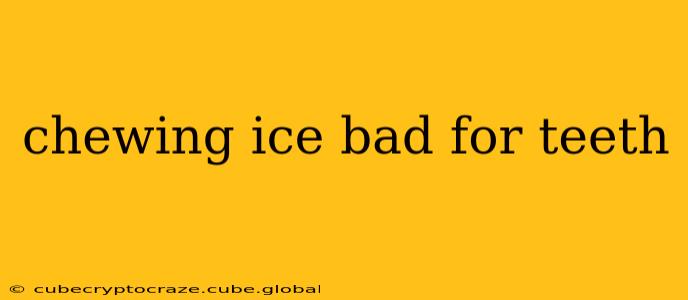Chewing ice may seem harmless, even refreshing, but the reality is that this seemingly innocent habit can wreak havoc on your teeth. While the occasional accidental munch on a stray ice cube is unlikely to cause significant damage, regularly chewing ice can lead to a variety of dental problems. This comprehensive guide will delve into the negative effects of chewing ice, answer frequently asked questions, and offer advice on how to break this habit.
What Happens When You Chew Ice?
The primary concern with chewing ice is the sheer force involved. Ice is incredibly hard, and repeatedly subjecting your teeth to this force can lead to:
- Cracked or chipped teeth: The enamel, the hard outer layer of your teeth, is the strongest substance in the human body, but it's not indestructible. The force of chewing ice can cause microscopic fractures, leading to cracks and chips, especially in teeth already weakened by decay or fillings.
- Fractured fillings: Existing dental work, such as fillings, crowns, or veneers, can be particularly vulnerable to the force of chewing ice. Ice can cause these restorations to crack or even break off completely, requiring costly repairs.
- Increased sensitivity: When the enamel is damaged, the dentin (the layer beneath the enamel) is exposed. Dentin is much softer and contains microscopic tubules that lead directly to the nerves in your teeth. This exposure makes your teeth significantly more sensitive to hot and cold temperatures, as well as sweet and sour foods.
- Worn enamel: Over time, the constant grinding of ice against your teeth can wear down the enamel, making your teeth more susceptible to cavities and other dental problems. This enamel erosion can also lead to a change in the appearance of your teeth, making them appear dull or discolored.
How Can I Tell if Chewing Ice is Damaging My Teeth?
Identifying the damage from chewing ice can be subtle in the early stages. Look out for these signs:
- Sudden tooth pain: Sharp, shooting pains, especially when consuming hot or cold foods or drinks, can indicate enamel damage.
- Visible cracks or chips: Carefully examine your teeth in a mirror. You may notice small cracks or chips that weren't there before.
- Increased sensitivity: If your teeth are becoming more sensitive to temperature changes or certain foods, it could be a sign of enamel erosion.
- Loose fillings or crowns: If you have dental work, check for any signs of damage or loosening.
Is Chewing Ice Worse Than Other Hard Foods?
While other hard foods like nuts and hard candies can also damage teeth, ice presents a unique challenge. Ice is much harder than these foods, and the act of chewing it often involves a forceful grinding motion, making it significantly more damaging to your teeth.
What are the Long-Term Effects of Chewing Ice?
The long-term consequences of regularly chewing ice can be severe. Ongoing enamel erosion leads to increased tooth sensitivity, a higher risk of cavities, and potentially the need for extensive dental work, including fillings, crowns, root canals, or even tooth extractions. This can significantly impact your oral health and overall well-being, leading to discomfort, infection, and costly dental bills.
How Can I Stop Chewing Ice?
Breaking a habit like chewing ice takes conscious effort and often involves identifying the underlying reasons behind it. Consider these strategies:
- Identify triggers: What situations or emotions lead you to chew ice? Addressing these underlying issues is crucial for breaking the habit.
- Find healthier alternatives: Keep your mouth busy with healthier options, such as sugar-free gum, crunchy vegetables, or even ice-cold water.
- Gradual reduction: Instead of quitting cold turkey, try gradually reducing your ice-chewing frequency.
- Seek professional help: If you're struggling to break the habit on your own, consider seeking help from a therapist or counselor.
Can I Repair Damage Caused by Chewing Ice?
While you can’t reverse enamel loss entirely, your dentist can help repair some of the damage. Depending on the severity, treatment options may include:
- Fillings: To repair cracks or chips.
- Crowns: To cover extensively damaged teeth.
- Bonding: To repair minor chips and improve the appearance of your teeth.
- Fluoride treatments: To help strengthen remaining enamel and prevent further damage.
In conclusion, while the occasional ice cube poses little threat, regularly chewing ice poses a significant risk to your oral health. By understanding the risks and implementing strategies to break the habit, you can protect your teeth and maintain a healthy, beautiful smile. If you're concerned about damage from chewing ice, consult your dentist immediately for an evaluation and treatment plan.
